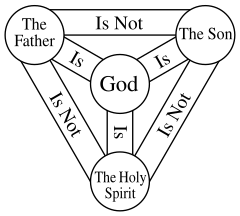Athanasian Creed: Christian statement of belief focused on Trinitarian doctrine and Christology
The Athanasian Creed is a Christian statement of faith.
It is also often referred to as Quicumque vult (can be translated as Whoever wants, the first two words of the statement). It is the first known creed to talk about trinity. It has been in use since the 6th century, mainly in the western part of the Church. It is not used very much today, the Nicene Creed has largely replaced it.

From about the 9th century people thought that St. Athanasius had written it. Athanasus lived in the 4th century in Egypt. Today, this view is largely seen as false. This is because of the following:
- The original text is in Latin. Athanasius wrote mainly in Greek.
- Neither Athanasius nor other people who lived at the same time as him mention it.
- It talks about problems that were only discovered after Athanasius' death.
Today, most people think it came from Gaul around the year 500. Its positions are similar to those taken by St. Ambrose of Milan, Augustine of Hippo or Vincent of Lérins. J.N.D. Kelly, a contemporary patristics scholar, believes that St. Vincent of Lérins was not its author, but suggests that it may have come from the same bacground, namely the area of Lerins in southern Gaul. Caesarius of Arles is one of the possible authors.
The oldest surviving manuscripts of the Athanasian creed date from the late 8th century.
Martin Luther said there were three statements of faith, the Nicene Creed (Credo in unum deum, I believe in one god..), the Te Deum (Te Deum Laudamus,..., Thee, O Lord, we praise), and the Athanasian Creed.
The creed starts:
| “ | Quicumque vult salvus esse, ante omnia opus est, ut teneat catholicam fidem: quam nisi quisque integram inviolatamque servaverit, absque dubio in aeternum peribit. | ” |
| “ | Whoever wants to be saved should above all cling to the catholic faith. Whoever does not guard it whole and inviolable will doubtless perish eternally. | ” |
It explains Trinity, in such a way to stand against positions such as Arianism. It has the filioque.
It ends
| “ | Haec est fides catholica; quam nisi quisque fideliter firmiterque crediderit, salvus esse non poterit. | ” |
| “ | This is the catholic faith. One cannot be saved without believing this firmly and faithfully. | ” |
References
Other websites

This article uses material from the Wikipedia Simple English article Athanasian Creed, which is released under the Creative Commons Attribution-ShareAlike 3.0 license ("CC BY-SA 3.0"); additional terms may apply (view authors). Content is available under CC BY-SA 4.0 unless otherwise noted. Images, videos and audio are available under their respective licenses.
®Wikipedia is a registered trademark of the Wiki Foundation, Inc. Wiki Simple English (DUHOCTRUNGQUOC.VN) is an independent company and has no affiliation with Wiki Foundation.